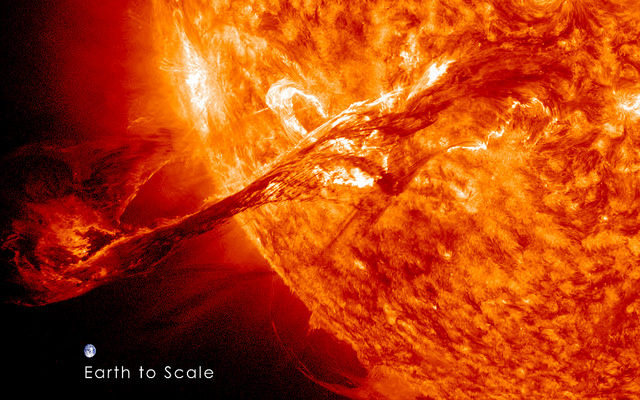We’ve got a mystery on our hands. The surface of the sun has a temperature of about 6,000 Kelvin – hot enough to make it glow bright, hot white. But the surface of the sun is not its last later, just like the surface of the Earth is not its outermost layer. The sun has a thin but extended atmosphere called the corona. And that corona has a temperature of a few million Kelvin.
How does the corona have such a higher temperature than the surface?
Like I said, a mystery.
One Corona, Hot, Please
As strange as it is, you wouldn’t feel the heat of the corona if you were to swim through it. It’s not just thin, but incredibly thin, registering just a trillionth of the density of the surface of the sun. It’s so thin that despite its high temperature, meaning that the little particles making up the corona are zipping around at incredible speeds, there are just so few particles in the first place that they would barely ever hit you – and you wouldn’t even register the scorchingly high heats.
(Just to be clear, your proximity to the surface of the sun itself would surely melt you anyway, but it wouldn’t be the fault of the corona.)
The corona itself is tremendously big, extending millions of kilometers, doubling the radius of the sun beyond its visible skin. But again, because it’s so thin it’s hard to see. Only during total solar eclipses, when the body of the moon perfectly hides the disk of the sun, does the corona in all its glory appear, glowing with light from the solar surface reflecting off the tiny particles that make up the atmosphere.
Detailed examination of the corona reveals very peculiar structures. Thin wispy filaments, long tenuous loops, and whorls resembling fingerprints dance throughout the sun’s atmosphere. So it’s very obviously a very active and complicated place, which might provide a clue to its hellishly high temperature.
Ultimate Power
There’s only one power source in the sun, and that’s nuclear power. In the deep, dense, hot core (ironically the only place that bests the temperatures of the corona), the incredible pressures overwhelm the natural repulsion of hydrogen, fusing them together to make helium. The conversion leaves a little bit of mass behind, and hence releases a little bit of energy.
Each individual reaction emits just a tiny little bit of energy, but repeat that process countless times and you end up with a fantastic, long-lived, powerful energy source, providing all the light for the entire solar system for billions of years.
And since it’s the only power source around, somehow heating up the corona.

It’s not hard to imagine why the surface of the sun, called the photosphere, is so much cooler than the innermost core. After all, that surface is exposed to the hard, cold, chilling vacuum of outer space, and is separated from the warming core by hundreds of thousands of kilometers of thick, soupy plasma.
But that surface is active, perhaps even more so than the turbulent corona above it. Granules, sunspots, flares, mass ejections, and more bubble and erupt from the sun’s chaotic exterior. Perhaps in that roiling inferno of the surface hides the enigmatic source of the corona’s high temperature.
Doing the Twist
So we have a relatively cool but incredibly active solar surface sitting underneath the intensely hot corona, and we need something to connect that activity and transform it into heat. Fortunately, the sun is a giant ball of plasma, which means it’s a mixture of charged particles moving around quickly. And charged particles moving around quickly are really, really good at making magnetic fields.
And magnetic fields in turn are really, really good at turning activity into heat.
Strong magnetic fields have long been suspected to play a major role in heating the corona, something that the Parker Solar Probe was sent to examine in more details. And in a recent paper, researchers using data from the Solar Dynamics Observatory have uncovered another two mechanisms to heat the corona with magnetic fields.
Sometimes the magnetic fields can wrap around themselves, forming a tunnel (going by the cool sci-fi name of flux tubes). These tunnels act as conduits for even more magnetic energy in the form of shocks and waves to travel from place to place…like from the surface to the corona.
Sometimes these fields can even twist up amongst themselves so tightly that they literally break like an overstretched rubber band, releasing all that pent-up energy in a single flash known as a magnetic reconnection event.
If these flux tubes and reconnection events happen often enough and deliver enough energy, they can supply the corona with more than enough heat to sustain it. This is still an open question, but with more observations and hard work, we may soon have a clear, detailed picture of the peculiar solar puzzle.
Read more: “On the rapid forced reconnection in the Sun’s corona for its localized heating”

